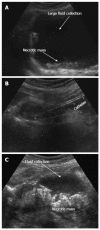Treatment of severe acute pancreatitis and its complications
- PMID: 25320523
- PMCID: PMC4194569
- DOI: 10.3748/wjg.v20.i38.13879
Treatment of severe acute pancreatitis and its complications
Abstract
Severe acute pancreatitis (SAP), which is the most serious type of this disorder, is associated with high morbidity and mortality. SAP runs a biphasic course. During the first 1-2 wk, a pro-inflammatory response results in systemic inflammatory response syndrome (SIRS). If the SIRS is severe, it can lead to early multisystem organ failure (MOF). After the first 1-2 wk, a transition from a pro-inflammatory response to an anti-inflammatory response occurs; during this transition, the patient is at risk for intestinal flora translocation and the development of secondary infection of the necrotic tissue, which can result in sepsis and late MOF. Many recommendations have been made regarding SAP management and its complications. However, despite the reduction in overall mortality in the last decade, SAP is still associated with high mortality. In the majority of cases, sterile necrosis should be managed conservatively, whereas in infected necrotizing pancreatitis, the infected non-vital solid tissue should be removed to control the sepsis. Intervention should be delayed for as long as possible to allow better demarcation and liquefaction of the necrosis. Currently, the step-up approach (delay, drain, and debride) may be considered as the reference standard intervention for this disorder.
Keywords: Acute necrotizing pancreatitis; Drainage; Gastrointestinal endoscopy; Infection; Sepsis.
Figures





References
-
- van Baal MC, van Santvoort HC, Bollen TL, Bakker OJ, Besselink MG, Gooszen HG. Systematic review of percutaneous catheter drainage as primary treatment for necrotizing pancreatitis. Br J Surg. 2011;98:18–27. - PubMed
-
- Zerem E, Imamović G, Sušić A, Haračić B. Step-up approach to infected necrotising pancreatitis: a 20-year experience of percutaneous drainage in a single centre. Dig Liver Dis. 2011;43:478–483. - PubMed
-
- Buter A, Imrie CW, Carter CR, Evans S, McKay CJ. Dynamic nature of early organ dysfunction determines outcome in acute pancreatitis. Br J Surg. 2002;89:298–302. - PubMed
-
- Johnson CD, Kingsnorth AN, Imrie CW, McMahon MJ, Neoptolemos JP, McKay C, Toh SK, Skaife P, Leeder PC, Wilson P, et al. Double blind, randomised, placebo controlled study of a platelet activating factor antagonist, lexipafant, in the treatment and prevention of organ failure in predicted severe acute pancreatitis. Gut. 2001;48:62–69. - PMC - PubMed
Publication types
MeSH terms
Substances
LinkOut - more resources
Full Text Sources
Other Literature Sources
Medical
Miscellaneous

